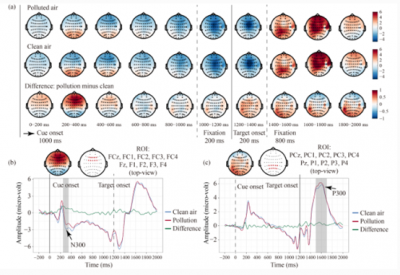Newswise — Air pollution, a major global health risk, is known for its detrimental physical effects, but its impact on cognitive functions like learning and driving has only recently been explored. Prior studies have indicated that exposure to air pollution can impair cognitive performance, behavior, and productivity, but the underlying neurocognitive mechanisms remained largely unexplored until now.
In a new study (doi:10.1007/s11783-024-1801-x) published on 10 December 2023, in the journal Frontiers of Environmental Science & Engineering, a research team from Nanjing University utilized an adapted dot-probe task paradigm and the ERP technique to investigate how visual stimuli of air pollution influence attention allocation. Participants were shown cues (either pollution or clean air images) before responding to targets in either the same or opposite visual field. Behavioral measures indicated that pollution images resulted in higher response accuracy in trials requiring attention shifts. ERP analysis showed that pollution images evoked lower N300 amplitudes, suggesting less attention-capturing effects, while these cues correlated with higher P300 amplitudes in attention-holding trials, indicating the need for more cognitive resources to maintain attention.
"Air pollution not only poses a significant threat to physical health but also impacts cognitive functions in a subtle yet profound manner," explains the study's lead researcher. "Our findings offer the first neuroscientific evidence of how air pollution distracts our attention, emphasizing the need for clean air initiatives to enhance cognitive wellbeing."
The study concludes that visual exposure to air pollution distracts attention and impacts task performance, with pollution cues resulting in lower accuracy in attention-holding trials but higher in shifting trials. Clean air captures more attention, as indicated by larger N300 amplitudes. These findings highlight the neurocognitive impact of air pollution, bridging environmental science and social cognitive neuroscience. The study urges attention to this phenomenon, particularly in developing countries.
###
References
DOI
Original Source URL
https://doi.org/10.1007/s11783-024-1801-x
Funding information
The study was financially supported by the National Natural Science Foundation of China (Nos. 71921003 and 72222012), the Jiangsu R&D Special Fund for Carbon Peaking and Carbon Neutrality (No. BK20220014), the Jiangsu Natural Science Foundation (No. BK20220125).
About Frontiers of Environmental Science & Engineering
Frontiers of Environmental Science & Engineering (FESE) is the leading-edge forum for peer-reviewed original submissions in English on all main branches of environmental disciplines. FESE welcomes original research papers, review articles, short communications, and views & comments. All the papers will be published within 6 months since they are submitted. The Editors-in-Chief are Academician Jiuhui Qu from Tsinghua University, and Prof. John C. Crittenden from Georgia Institute of Technology, USA. The journal has been indexed by almost all the authoritative databases such as SCI, Ei, INSPEC, SCOPUS, CSCD, etc.
Journal Link: Frontiers of Environmental Science & Engineering
MEDIA CONTACT
Register for reporter access to contact detailsArticle Multimedia

Credit: Frontiers of Environmental Science & Engineering
Caption: Graphic abstract

Credit: Frontiers of Environmental Science & Engineering
Caption: ERP comparison between pollution and clean air cues in attention-holding trials. (a) Topographic plots of ERP waves show the brain activities in attention-holding trials per 200 ms with pollution images (the first panel) and clean air images (the second panel) as the cue. The third panel shows the ERP difference waves between pollution and clean air conditions. (b) Mean ERP waves for the channels of N300 ROI. (c) Mean ERP waves for the channels of P300 ROI. Gray rectangles indicate time windows of interest.

